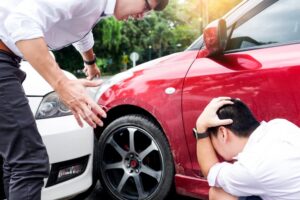Imagine sitting at a red light, waiting for the light to go green. Suddenly, you see a car approaching too quickly in the rearview mirror, and it rear-ends you at 20 miles per hour. You are bruised and battered, and your arm and head hurt. This is a classic example of a rear-end collision. In most rear-end accidents, the fault is clear, and the other driver is at fault. But these accidents can sometimes be more complex. Learn more about rear-end accidents in this article. If you were rear-ended recently and have legal questions, speak to a Tampa car accident attorney in your community today.
Schedule a Free Initial Consultation
What Is a Rear-End Collision?
 A rear-end collision happens when a driver runs into the vehicle before them. These motor vehicle accidents usually happen at a stop sign, red light, or in traffic.
Most rear-end crashes happen at low speeds, but they also happen at highway speeds on the interstate. Most rear-end collisions involve two vehicles, but there also can be a chain reaction involving many vehicles.
Some common ways that rear-end collisions happen are:
A rear-end collision happens when a driver runs into the vehicle before them. These motor vehicle accidents usually happen at a stop sign, red light, or in traffic.
Most rear-end crashes happen at low speeds, but they also happen at highway speeds on the interstate. Most rear-end collisions involve two vehicles, but there also can be a chain reaction involving many vehicles.
Some common ways that rear-end collisions happen are:
- The rear driver rolls forward at a few miles an hour into the front driver's vehicle.
- The rear driver slams into the other vehicle at a high rate of speed.
- The rear driver was going faster than the front driver, and the cars hit each other while in motion.
Safe Following Distance And Rear-End Crashes
A common question in rear-end accidents is whether the rear driver did not maintain a safe following distance in the seconds before the accident. The CDC states that a car going 55 miles per hour travels about 60 feet before the typical driver can hit the brakes and slow down in an emergency. Also, a typical car going 55 miles per hour needs about 160 feet to stop. So, this is a total of approximately 220 feet at 55 miles per hour, assuming dry road conditions. If the rear driver failed to maintain a safe following distance and collided with you, authorities will likely attribute fault to them. The police, insurance companies, and attorneys investigating the case can review the crash scene evidence and determine if the driver violated safe following distance rules.Three-Second Rule In Rear-End Collisions
Many states have stated in their driver's manual that drivers use the three-second rule to stop drivers from tailgating. This means drivers should note a stationary object on the street, such as a traffic sign, and count three seconds between their vehicle and the next one. In good weather in daylight, the three-second rule can help drivers to avoid rear-end collisions. In poor weather or at night, extending the time to four, five, or six seconds may be necessary. After an accident, proving that the rear driver violated the three-second rule isn't easy. But your attorney can investigate tire marks on the road, eyewitness testimony, and perhaps surveillance video to determine if the driver was following too closely.How to Determine Fault for a Rear-End Collision
 Every driver on public roads is responsible for following other motor vehicles at a safe distance. How far you should be from the vehicle in front depends on many factors, including car speed, time of day, weather conditions, etc.
Drivers who violate their duty of care and hit another vehicle are usually found negligent. That is why, in a rear-end crash, the driver in the rear is usually the one to pay for damages.
Receiving compensation in a rear-end collision mostly comes down to proving negligence. Negligence is how we describe behavior below a typical level of care that injures others.
A driver is at fault if they do not drive or behave reasonably and hurt someone. However, what is reasonable behavior on the road? It depends on what the surrounding circumstances were when the accident happened.
Proving that the other driver was at fault in the rear-end collision means showing they had a duty of care. This means showing, for example, that the rear-end driver had a duty to drive safely, obey traffic laws, and maintain a safe distance from other vehicles. This is fairly easy to prove; all public road drivers must drive with an appropriate duty of care.
Next, you must show that the other driver breached their duty of care when they rear-ended you and that you suffered damages.
Every driver on public roads is responsible for following other motor vehicles at a safe distance. How far you should be from the vehicle in front depends on many factors, including car speed, time of day, weather conditions, etc.
Drivers who violate their duty of care and hit another vehicle are usually found negligent. That is why, in a rear-end crash, the driver in the rear is usually the one to pay for damages.
Receiving compensation in a rear-end collision mostly comes down to proving negligence. Negligence is how we describe behavior below a typical level of care that injures others.
A driver is at fault if they do not drive or behave reasonably and hurt someone. However, what is reasonable behavior on the road? It depends on what the surrounding circumstances were when the accident happened.
Proving that the other driver was at fault in the rear-end collision means showing they had a duty of care. This means showing, for example, that the rear-end driver had a duty to drive safely, obey traffic laws, and maintain a safe distance from other vehicles. This is fairly easy to prove; all public road drivers must drive with an appropriate duty of care.
Next, you must show that the other driver breached their duty of care when they rear-ended you and that you suffered damages.
What Causes Rear-End Collisions?
Drivers in rear-end crashes can breach the duty of care in many ways. For the rear driver, this may mean:- Not paying attention to the road and other cars, including looking for stopped cars.
- Using a cell phone or other electronic device while the vehicle is in motion.
- Not stopping their vehicle within a reasonable time.
- Driving at an unsafe speed, according to weather conditions.
- Driving while under the influence of drugs or alcohol.
- Not following the other vehicle at a safe distance.
Is The Driver In Front Ever At Fault For A Rear-End Collision?
Not usually, but there are limited situations where the driver in front can be at fault:- The front driver suddenly puts the vehicle into reverse.
- The brake lights in the front vehicle don't work correctly.
- The front driver slams on the brakes for no reason, known as a brake check.
- The front driver has a mechanical issue, but they don't move to the side of the road.
Common Rear-End Collision Injuries
Many people think that rear-end collisions are usually fender benders with minor injuries. However, many severe and sometimes fatal injuries can occur in rear-end crashes. Accident victims can feel the effects of the rear-end accident for months, even years. Some of the most common rear-end accident injuries are listed below. Seek immediate medical attention if you experience a rear-end collision; do not delay. You can be seriously injured and initially unaware of it.Neck Injuries
Whiplash is probably the most common rear-end crash injury. This may involve various injuries to soft tissues in the neck, such as tearing or straining ligaments and tendons. The soft tissues in the neck also can be sprained or strained. The rear-end collision may cause your head to snap back and forth quickly, which can cause whiplash injuries and symptoms. This injury is sometimes not taken as seriously by insurance companies, but whiplash can be painful and debilitating. It's especially important to seek immediate medical attention if you have whiplash. The doctor should document and treat the injury quickly. This ensures the best medical outcome and will make filing a personal injury claim easier later. Connecting the neck injury to the accident is critical, especially for a soft tissue injury that may not be as obvious as a broken arm or leg.Back Injuries
In a rear-end accident, various parts of the back, including muscles, joints, discs, and soft tissue, can sustain serious injuries. Most body movements involve the back, so an upper or lower back injury can be severely debilitating. People with a serious back injury may take weeks or months off work and require long-term care to recover fully. If physical therapy fails to resolve your back pain, you may require surgery.Head Injuries
Rear-end crash victims may slam their heads into various objects in the vehicle, such as the dashboard, windshield, steering wheel, or windows. Also, just a sudden jolt to the head can cause a serious brain injury. Most rear-end crashes cause at least a mild concussion, but the injury can be more serious. If you feel dizzy, disoriented, or have head pain after a rear-end crash, go to the ER immediately.Spinal Injuries
 The spinal cord is one of the most important parts of the body, allowing us to move and sense the world around us. A serious rear-end collision can easily damage the delicate spinal cord tissue. People with spinal cord injuries after car accidents can become permanently disabled. Only an experienced personal injury attorney should handle such a serious injury and legal claim.
The spinal cord is one of the most important parts of the body, allowing us to move and sense the world around us. A serious rear-end collision can easily damage the delicate spinal cord tissue. People with spinal cord injuries after car accidents can become permanently disabled. Only an experienced personal injury attorney should handle such a serious injury and legal claim.
Broken Bones
Many bones, such as the arms, hands, collar, and facial bones, can be broken during a rear-end collision. Some broken bones only require a few doctor appointments and an initial setting to heal fully. But other broken bones can require surgery and months of recovery.Summary
Generally, rear-end accidents are the fault of the rear driver. In most accidents, the rear driver is distracted by something, such as a cell phone, radio, or a conversation with passengers, or is under the influence of drugs or alcohol. They may rear-end you at a stop light, red light, or in traffic. In most rear-end crashes, the fault is relatively easy for your car accident attorney to prove. There may be tire marks on the road, eyewitness testimony, and possibly video evidence to show that the other driver violated their duty of care and hit you. Your attorney will take this evidence and negotiate with the at-fault driver's insurance company for a personal injury settlement. However, in some accidents, one can question the assignment of fault. For example, if your brake lights aren't functioning, there can be a dispute about who is liable for the accident. If an insurance settlement cannot be agreed on, your attorney may recommend filing a personal injury lawsuit.Speak to a Car Accident Attorney Today

